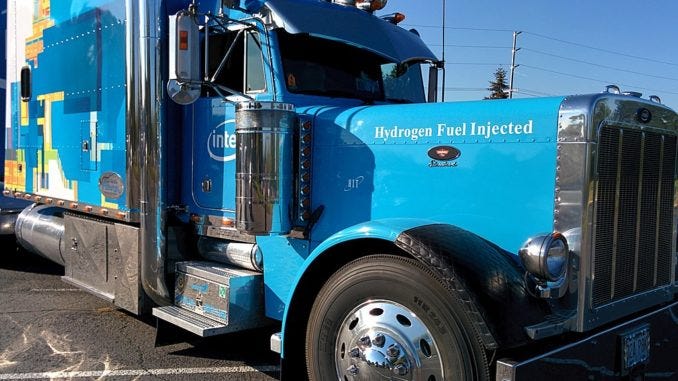In the fourth part of this series following EVolution Hybrid, a project integrating a traditional semi-truck with a combustion engine with an EV battery and electric vehicle technology we get an update on the engine features, roadblocks and successes.
In this interview with Levi Perkins, Perkins Electric Innovation, and Kenley Nebeker, TrainND Northwest, the two discuss how EVolution Hybrid is ready to take on these traditional challenges, plus a couple anticipated ones too.
“I think in the past a lot of the electric vehicles that we've seen on the market, whether it be a very small passenger vehicle, like a car or even a small utility pickup,” Perkins said.
The interview does a great job of explaining where the EV market is for Semi-Trucks and major fleet sized vehicles.
“So what we'll see on those a lot of times older electric vehicles that we saw in the nineties, a lot of those had 3 to 400 volts DC to permanent magnet motors and they were D. C. Motors and some of them were even brushed DC motors, so there would be maintenance involved with them,” Perkins said.
Some of the early electric conversions were actually brushed DC motors, according to Perkins.
“If you think about it like the electric drill market right now versus 15 years ago,” Perkins said. “We used to have these 12 volt electric drills and were really low power. They had brushed DC motors, they were really heavy.”
Perkins continued his comparison to the electric drill evolution.
“They probably had nickel cadmium batteries. They didn't have a lot of duty cycle really high, you know, minutes or hours of charge time. Just not convenient. People didn't like them,” Perkins said. “But as things progressed, we went to to brush less motors or permanent magnet motors. Like if you think of Milwaukee or DeWalt or some of these, and then we went to a higher voltage, so we would see 16 volts a long time ago.”
Then 18, 20 and then even 24 volts and some of them for a while Perkins added.
“We had 28 volt flat systems, the same thing with the electric vehicle market,” Perkins said. “Now we're seeing uh 600 volts is the standard. And we even have some vehicles that are running in the 800 volt range and some medium duty trucks and class eight trucks that are in the 800 volt range because we can potentially consume, we can extract more power, useful power out of a smaller battery pack.”
Perkins also issued a safety warning with these Electrical Evolutions.
“The voltage is higher and it's dangerous. I mean, if people have ever told you that you can't be killed by DC voltage, that's a lie,” Perkins said.
This is exactly the reason for EVoltion Hybrid. To ensure the transition into the new economy is as safe as possible for everyone.
In Part Three the challenge is towing and range anxiety.
“If we have a greater amount of weight that we are towing or resistance whether it be a vertical incline or bad roads or a low tire, just things that will impact how much power we are using and increase the amount of amperage by the motor, and that would consume the battery quicker.”
Towing creates conversations about torque as well.
“The electric motors we are using they can build what we call Peak Torque at a really low if not zero RPM,” Perkins said. “This is different from a reciprocating piston where your peak torque could be at a specific RPM usually in the RPM range.”
The interview also discussed tires and how many electric vehicles have specific tires for the vehicle and if someone put new tires on, it impacts how far you can drive. So does temperature.
“An individual going to see his son on Christmas on the east coast was set to drive 200 miles in the below freezing temperature after he hit the SuperCharge Station close to his house,” Perkins said. “When he left his garage the Tesla battery was warm enough to start and drive, only when he got to the charge station and at that point the battery has discharged some but it’s cool enough it will not allow him to charge.”
This transitioned into one of the biggest issues right now for the EV Transition is “Range Anxiety”. Nebeker has had first hand experience and says it is a real thing.
“I experienced range anxiety first hand and absolutely it is real,” Nebeker said. “That question of am I going to get where I need to get is a real worry with range anxiety. With an internal combustion engine with gas motors, you know you have until empty then you have to fill it up. It’s a consistent draw versus unpredictability really.”
In Part Two, the two talked about time and money.
When it comes to life, time is money. In transportation it’s time and weight that equal money. Well in the world of EV Transportation, it’s time, weight and temperature that mean money.
In Part One, the two gave an overview of project EVolution Hybrid, which is integrating an electric battery into a traditional combustion engine while maintaining the classic trucking look. With maybe a hint of flare or contemporary fashions.
“One of the things we looked at with the EVolution Hybrid is the future of the transportation and trucking industry,” Kenley Nebeker, executive director, TrainND Northwest said. “We are really trying to find a way to expose our students and the community to the potential that lies within the electric truck, or in this case a hybrid truck. I’ve never been a believer in all-one-way or another.”
Nebeker is referring to an all EV solution or an all fossil fuel solution. Nebeker believes this project will shine a light on how a “marriage” between the two concepts will ultimately become a viable solution to an energy transition.
“One important part of this project is the look,” Nebeker said. “I like that traditional Americana semi truck look and understand that still connects with the public too.”
Click here for Part Two of The Crude Life’s series on EVoltion Hybrid: Transporting Innovation Into A Sustainable Society
Click here for Part One of The Crude Life’s series on EVoltion Hybrid: Transporting Innovation Into A Sustainable Society
One of the ways the electric combustion collaboration can occur is weight. According to Perkins, the weight of fuel, the batteries and cargo are factors when determining your bottom line in business.
“Most Class A trucks vary as there are different models from the manufacturers, but there’s a lot that is similar” Perkins said. “The less a truck can weigh, the more freight you can haul and essentially, generate higher revenues because of it.”
For fleets, this could have significant savings. Perkins dives into the details of sleeper cabs, drop steer axles and other accessories when discussing the weight and revenues in trucking. All these additional details matter when discussing electric batteries and transition.
“Most electric trucks are going to be in the 400-600 kilowatt hour range. Tesla just released a 1000 kilowatt hour battery,” Perkins said. “But interestingly enough in the past three years the battery technology has allowed us to have reductions in weight but still, it is over 10,000 pounds in battery weight.”
The interview also discussed the difference between fuel weight and battery weight. Which would save money in the long haul? Host Jason Spiess cited an example of an interview with Keri Frank, CEO, Comply365, and her integration of iPads in aviation.
“Before iPads, the industry had a 50-plus-pound black metal box that contained procedure papers required by law,” Spiess said. “After Keri Frank got the industry to transition those papers to an iPad, not only did they see an immediate impact by not printing new sheets every time a new code was issued. But the real savings they saw was over a year in fuel savings. The weight over time was nickels turning into dollars.”
Both Nebeker and Perkins agreed with the sustainable savings and how trucking companies will see similar results.
Another area of change or transition EVoltion Hybrid will see is jobs. Nebeker is anticipating changes with mechanics, IT and other areas of trucking and transportation, and is in constant contact with the supply chain and supporting cast.
Here are some supporting interviews for EVoltion Hybrid and the community of Williston, ND.
Williston’s Wenko Says Economic Development Getting More Diverse
Williston Mayor Talks About The Bakken’s Continued Community Growth
Bakken Small Businesses Staying Busy
Bakken Boom Created An Astounding Educational Opportunity For Williston State Students
The project is scheduled to take 9-12 months, depending on the supply chain, according to Nebeker.
Interviews are sponsored in part by TrainND Northwest – It’s a competitive world. Train for it.
Support American Entrepreneurs! Click on the image and use the promo code OTIS!
SUPPORT ESG UNIVERSITY! Paid Subscriptions keep the articles, essays and insights coming…
Click on picture for BIG SAVINGS! Check out these Amazing American Environmental Entrepreneurs! Don’t forget that the promo code OTIS unlocks big big savings!
SUPPORT ESG UNIVERSITY!
Questions or Comments? Do you have an ESG University story idea or Screenshot Submission? Email: hello@esgu.org
Supporting ESG University is more important than ever. Education and awareness are the best ways to tackle a complex problem, but it takes resources.
Raising awareness, presenting different angles to issues and insightful essays are some of the ways ESG University is helping others understand.
Click here for MyStore (promo code OTIS)
Click here for MyPillow (promo code OTIS)
Would you like to support ESG University? If so, we have a few FREE ways to support - subscribe, like, share and/or comment below!
HOWEVER….. We keep the lights on with paid subscriptions. Please consider supporting ESG University and subscribe today!
Or DONATE VIA VENMO (click on image to donate)






















Share this post